In this Article:
“I won’t carry anything in a pistol caliber that doesn’t start with a four.”
This is the philosophy of many old-time (and some newer) shooters who grew up with the .45 ACP being the King of the Hill in effective pistol cartridges. To them, the .45 ACP is the only round to carry or shoot in competition. It tends to shoot a fairly heavy bullet, sometimes referred to as a Punkin ball in its original form of an FMJ 230 grain round-nose FMJ bullet.
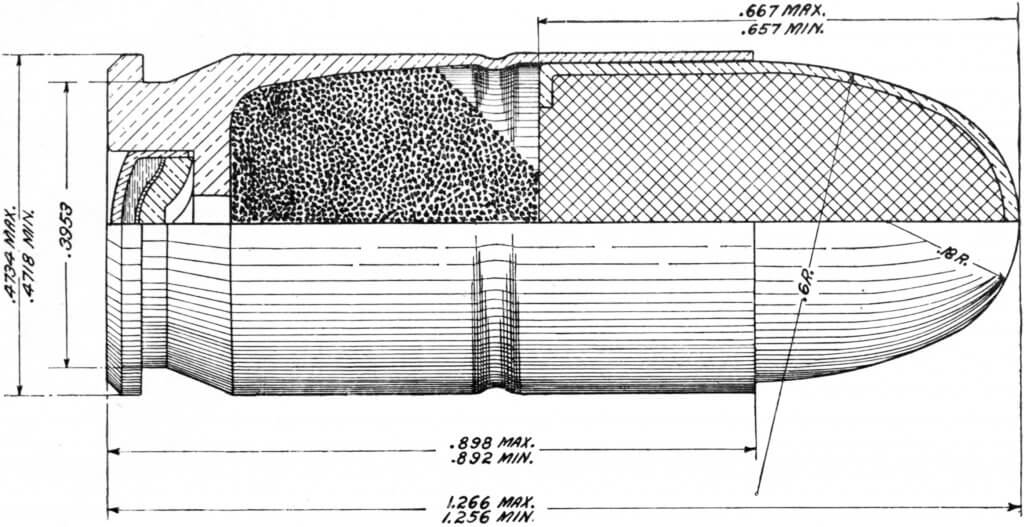
Short History of the .45 ACP Caliber
In 1898, our Army learned a lesson the hard way in the Philippine-American War during the Moro insurrection that the issue .38 Long cartridge just wasn’t effective. The natives would bind their bodies tightly with long grass as a sort of body armor, enhance their courage chemically (get high) and attack with blades and spears.
The anemic .38 Long was a poor stopper, as warriors could take four or five rounds but still be able to come in and do nasty things with their blades. The carnage stopped, however, when the Army broke their old Single Action Army .45 Colts out of mothballs and put them in the field. Pretty much a one-shot-stopper, the old .45 Colt did what the .38 Long couldn’t.
Enter the .45 ACP Cartridge
The lack of stopping power in the .38 round, coupled with the effectiveness of the .45, gave impetus to the 1904 Thomspon-LeGarde ballistic tests. Army Ordnance member Gen. John T. Thompson (who would make a larger mark in the world of firearms a few years later with his design of the .45 caliber submachine gun affectionately known as the “Tommy Gun”) got things rolling.
His partner, Major Louis LeGarde, was in the Medical Corps, not Ordnance. They wanted forensic evidence of the stopping power of different cartridges. A request for a new semiautomatic pistol firing a cartridge of not less than .45 caliber soon followed. Hence, the requirement for the adoption of a .45 caliber semiautomatic weapon. Several arms makers submitted guns, and Colt was among them.
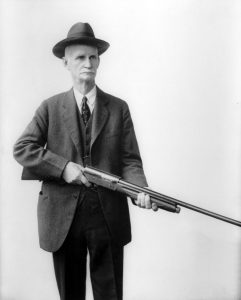
Colt had been working with John Browning on a .41 caliber cartridge/ gun combo, but with the Army’s request for a .45, Browning switched gears and came up with a new gun, the Model 1905 .45 Automatic Colt Pistol (ACP) semiauto.
Revolvers controlled the military, particularly in the British Empire, therefore semiautomatic pistols were novel. However, forward-thinking Ordnance men prevailed. The experiments started in 1906 with two P08 Lugers and a.45 ACP Savage, and Colt won the trials.
One major test had the two remaining test pistols fire 6,000 rounds in two days; the Colt got so hot it had to be dunked in water to cool it down but it won over the Savage entry with zero malfunctions. The Savage had 37. On March 29, 1911, the Model of 1911 .45 ACP was adopted. After a few changes, the gun settled into its place in history firing a 230-grain round-nose ball bullet (FMJ) at 830 fps. It was originally designed to fire a 200-grain round-nose bullet but that was upgraded to 230 grains in search of better terminal ballistics.
After some upgrades in 1921, the A1 model was introduced. The M1911 in various forms was the issue sidearm for our military for 74 years.
BONUS OFFER: Get your free shooting range targets to print at home!
Get your free targets to print at home!
The Best .45 ACP Pistols
OK, now that we know where .45 ACP ammo came from, what about a few guns to shoot it in? We’ll look at a few of my favorites but will not touch on the 1911 except to mention it in passing. Here are my favorites.
Best .45 ACP Pistols: Glock 30 Gen 3 Subcompact
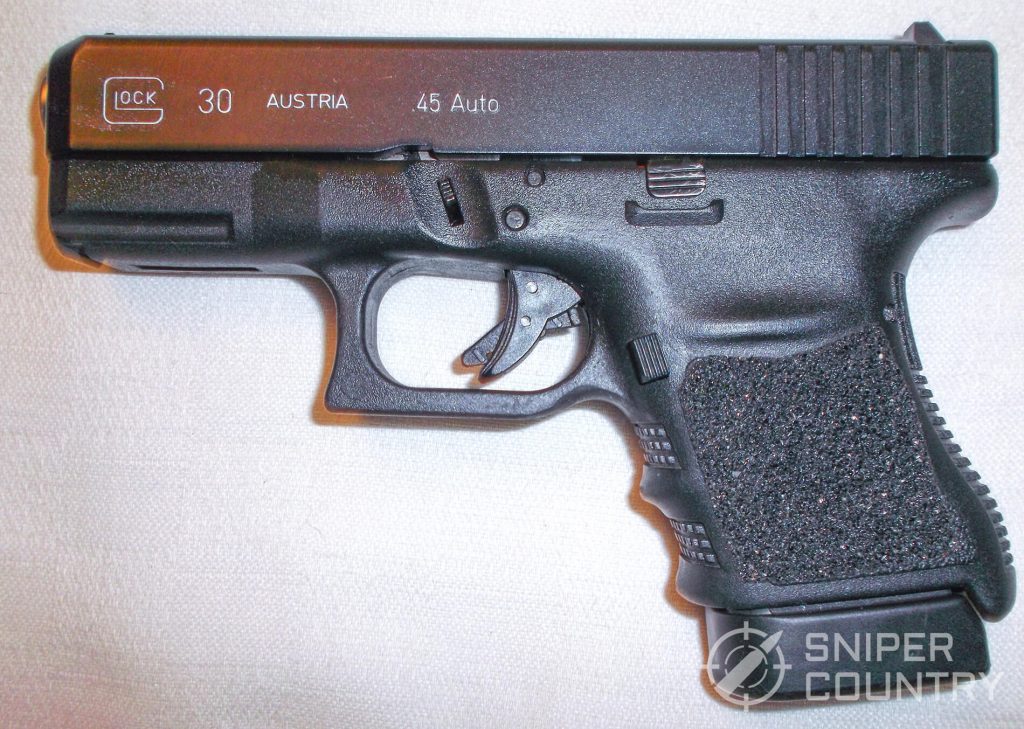
Glock makes several models of .45 Autos. I own the subcompact model. But I will also discuss other Glock models in .45 ACP.
Background
Glock is a household word in the firearms industry, but the company didn’t start that way. Gaston Glock had heard that the Austrian military was looking for a new issue sidearm in 9mm. He and friends in Austria who were more knowledgeable about gun design (he sold plumbing supplies and household goods) put together a single prototype, showed it to the military and the rest, as they say, is history.
His company grew to the point where it now supplies about 70% of law enforcement pistols in the U.S.A., not to mention the rest of the world. Like ‘em or not, Glocks are here to stay, and the .45 ACP is a big part of the output.
Glock and the .45 ACP
I chose to write about the M30 Glock because I was familiar with it. Glock makes four different .45s: the full-size 21 and 41, this 30, and the single-stack 36. You have the option with some of them to get a smaller frame (sf). I illustrate the different models below. No matter what you need in a .45, Glock probably has one for you.
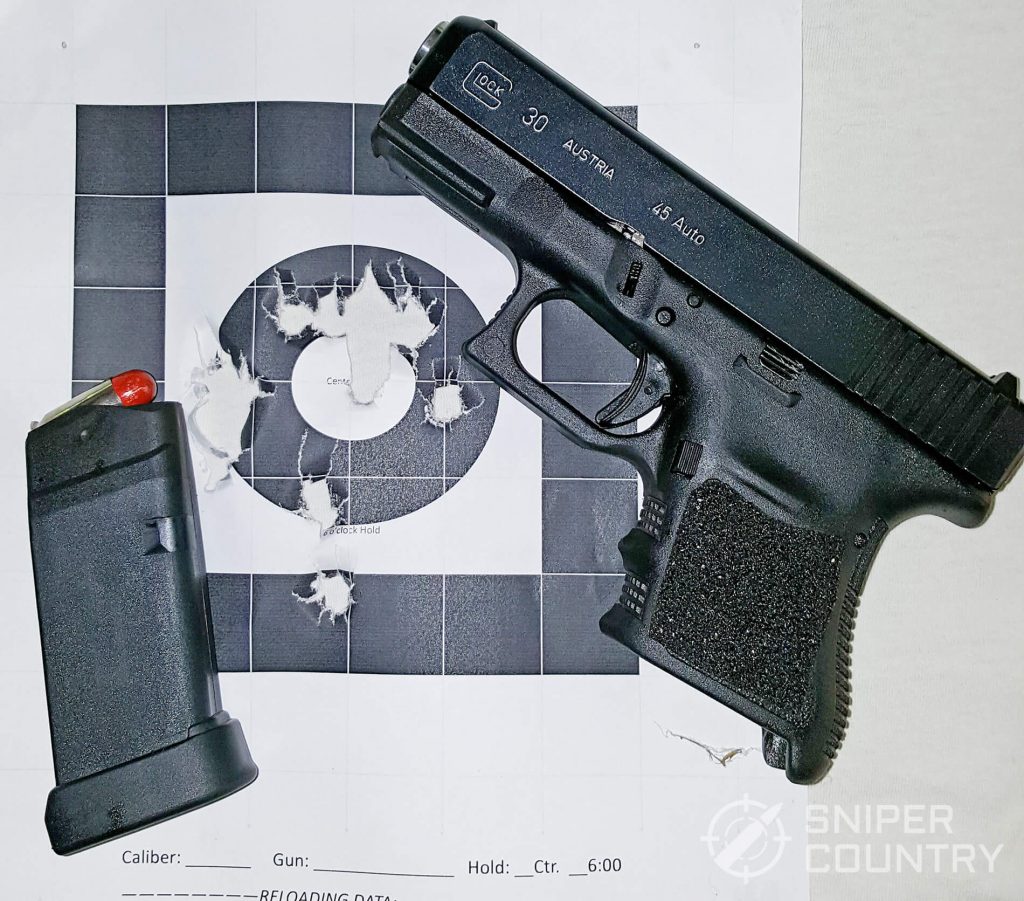
One thing you may notice in the photo above. I do not like the factory grip texturing on my Glock as it’s too smooth. So, I affixed some stair-tread tape, cut to shape, on the sides of the grip, and it is now anchored in my hand when I shoot it. I have no trouble with the finger grooves. Again, another can of worms — but the thing was too slippery so I fixed it.
The only modification I made was to put a drop of bright orange nail polish in the white dot recess on the front sight. All my handguns are adorned, as my aging eyes can see orange better than white against black targets. The basic differences between models go something like this.
 Model 30 — subcompact, 3.8″ barrel, ten round capacity
Model 30 — subcompact, 3.8″ barrel, ten round capacity Model 21 — duty-type gun, 4.6″ barrel, full-size, thirteen-round capacity
Model 21 — duty-type gun, 4.6″ barrel, full-size, thirteen-round capacity Model 41 — competition gun, 5.3″ barrel, same capacity as above, more expensive, ability to add optics
Model 41 — competition gun, 5.3″ barrel, same capacity as above, more expensive, ability to add optics Model 36 — concealed carry version, 3.8″ barrel, single-stack, six-round capacity
Model 36 — concealed carry version, 3.8″ barrel, single-stack, six-round capacity “SF”-Framed Versions — shorter frame, reduced grip size; “S” models, slightly thinner slide
“SF”-Framed Versions — shorter frame, reduced grip size; “S” models, slightly thinner slide
If you own other Glocks and are looking to get into the .45 game, these are what you have to choose from.
Best .45 ACP Pistols: S&W M&P 45 2.0 Compact
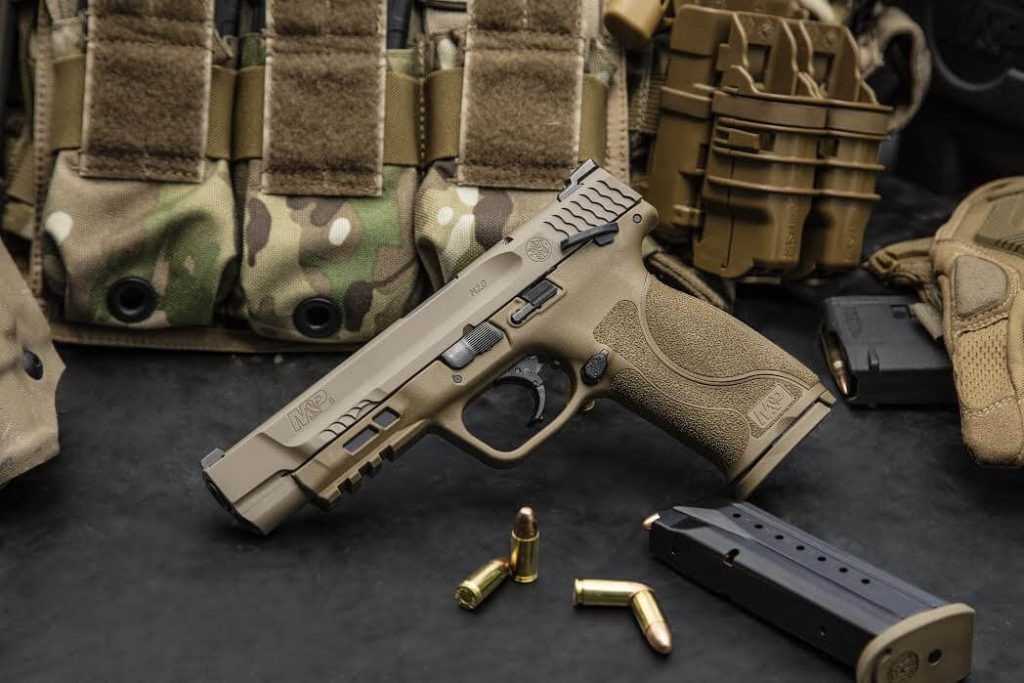
The original M&P handgun was a .38 Special revolver designed for military and police use in 1899, hence the M&P. This became the Model 10 and has been in continuous production with over six million made.
Fast-forward to today, the M&P line includes pistols and revolvers of different sizes and calibers and a rifle or two. They have expanded the line and rely on the M&P’s reputation earned over a century to help sell guns. The M&P pistols are very well-made and popular. Calibers include .45 ACP, .40 S&W, 9mm, .380 and even .22LR. Gun variations branded by M&P include full-size, compact, and subcompact (the Shield line). We will focus on the full-size model here.
The .45 ACP M&P is built to be nearly indestructible, with a polymer-framed, stainless steel chassis, the gun is solid. The black Armornite slide finish is very tough and tends not to show normal wear as easily as some finishes. Four interchangeable backstraps help you fit the gun to your hand and a Novak rear Lo-Mount Carry sight paired with a steel dovetailed front sight gives a great sight picture.
The 2.0 model has been improved over the original M&P by, among other things, making the trigger better and adding small forward slide serrations.
Popular Articles
Best .45 ACP Pistols: Springfield XD(M) Full Size
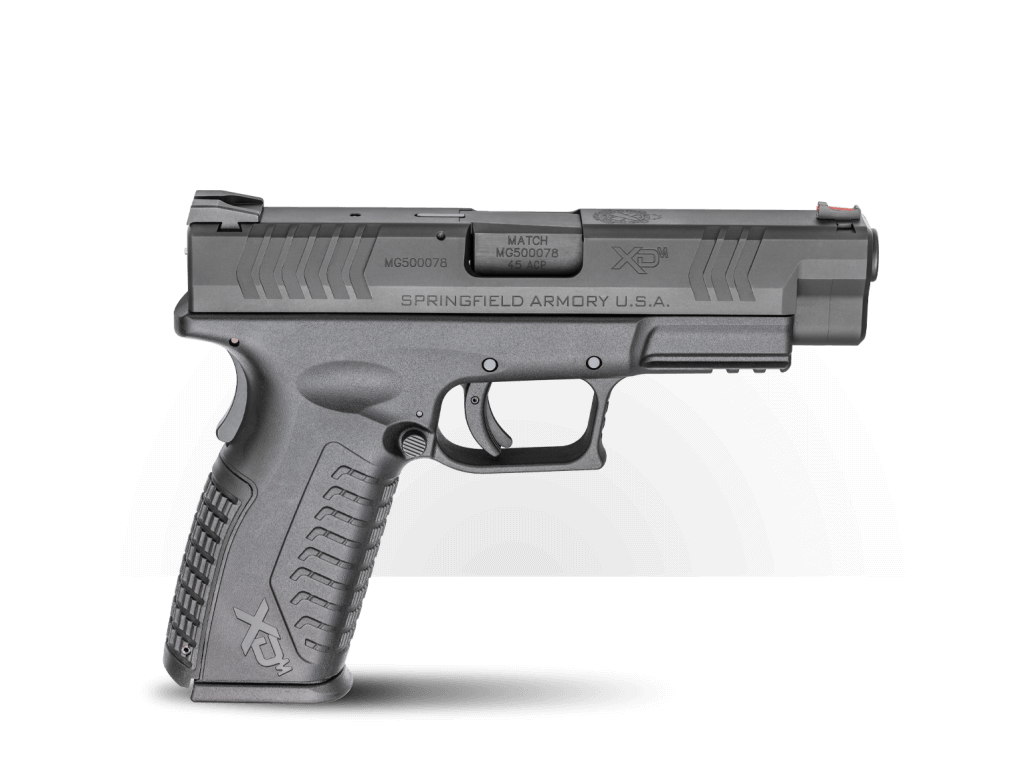
The Springfield XD family of pistols is extensive. The XD(M) is the full-size version. Ddifferent barrel lengths and capacities are available as different models in the XD line.
In 1999, IM Metal Corp. of Croatia introduced a polymer-framed pistol, the HS-2000. It was so well-received that the gun crossed Springfield Armory’s radar and they contracted for it to be produced for the U.S. The XD stands for eX-treme Duty.
The .45 ACP family is well-represented in the XD line. You can get a small, five-shot concealable XD(S) if you want something that fits in your waistband, but the full-size XD(M) is a very versatile choice. The Melonite-finished 4.5″-barrelled gun is concealable, if you want it to be. But this pistol shines is as a duty weapon or a competition gun.
The thirteen-round magazine capacity is standard for modern full-size .45 ACP polymer guns. Springfield’s fiber optic front sight is interesting. I owned an XD(S) and was surprised to find in the plastic pistol case it came in two different colors of replacement fiber optic rod, red and green.
You will find the XD(M) in the holsters of some law enforcement agencies, but the gun’s larger body of users consists of legal concealed-carry license holders. This is a very safe gun to carry as the XD(M) is one of few polymer-framed pistols to utilize a 1911-style grip safety. This feature either endears it to shooters (those 1911 fans) or turns others off (those non-1911 fans). Whichever camp you’re in, you would be hard-pressed to find a more reliable, solid gun than the XD(M).
BONUS OFFER: Get your free shooting range targets to print at home!
Get your free targets to print at home!
Best .45 ACP Pistols: Kahr CT45
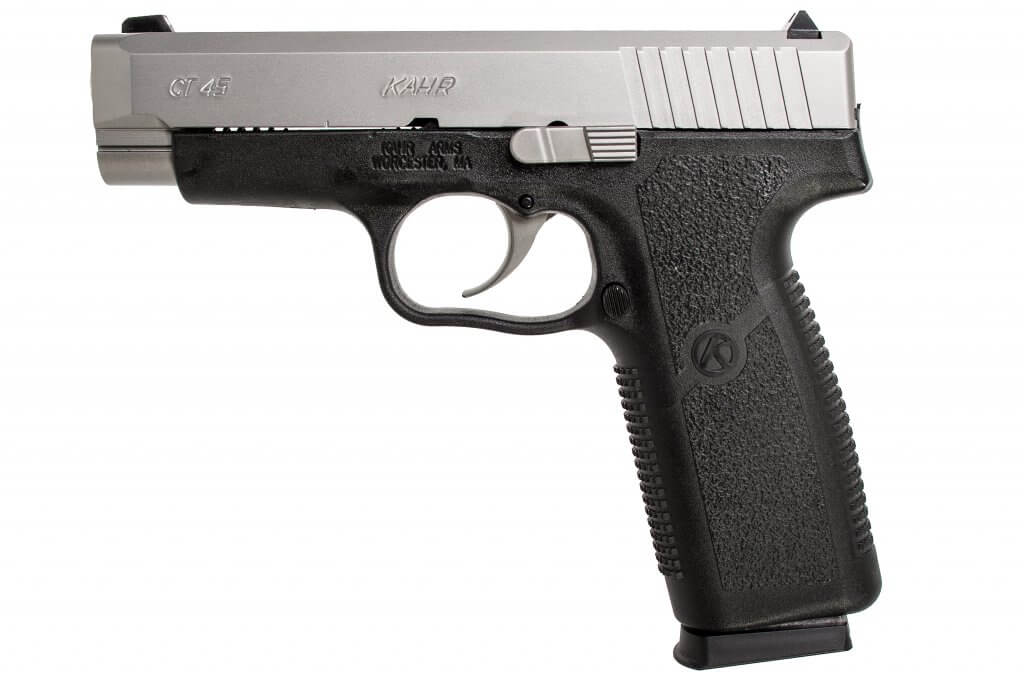
The CT45 is one thin .45. I owned a gun very similar to this one, a CW45 at the same time, I also owned its (smaller) stablemate, the 9mm CM9, and was impressed with both guns. Kahr guns cut right to the chase. There is nothing on them that is not essential for function. The CT45 is extremely popular with people looking for a concealed-carry .45 yet don’t want to break the bank.
Kahr Arms was founded by Justin Moon in 1995. It is currently under the Kahr Firearms Group umbrella, which manufactures Kahr Arms, Thompson, Auto-Ordnance and Magnum Research guns and accessories.
Based in Greeley, Pennsylvania, Kahr is an American company. Kahr made its reputation in the 1990s with the K9 9mm, which was popular with (among others) New York City police as a back-up gun. Expanding its product line, Kahr introduced the C series of guns a few years later to be a little more affordable than the P series. Some differences include.
 A stamped slide release lever instead of a machined one
A stamped slide release lever instead of a machined one Conventional rifling as opposed to polygonal rifling
Conventional rifling as opposed to polygonal rifling Roll-mark engraving on the slide instead of laser-etched
Roll-mark engraving on the slide instead of laser-etched Slightly less exterior slide machining: not as svelte as the P series
Slightly less exterior slide machining: not as svelte as the P series
As a cast bullet shooter, I appreciated the conventionally-rifled barrel, as most polygonally-rifled barrels do not like lead bullets. I also appreciated the fact that I was getting (with the differently-rifled barrel and a few cosmetic changes) basically the same gun as the more-expensive P 45 but at a fraction of the cost.
The Kahr family includes 10 different .45s. If you want to spend more, you can get a steel-framed gun with night sights, polygonally-rifled barrel, machined slide release, etc. It’s just that, you don’t have to spend more to get a functional, reliable .45. The CT45 will fill the bill.
I never had any trouble with reliability or function with the CW45 I owned, and it was small enough to fit in some of my pockets in a pocket holster (it holds one less round than the CT45). Not too many .45s can make that claim. It was accurate, easy to shoot, and was a gun that went with me a lot.
Best .45 ACP Pistols: Hi-Point JHP45
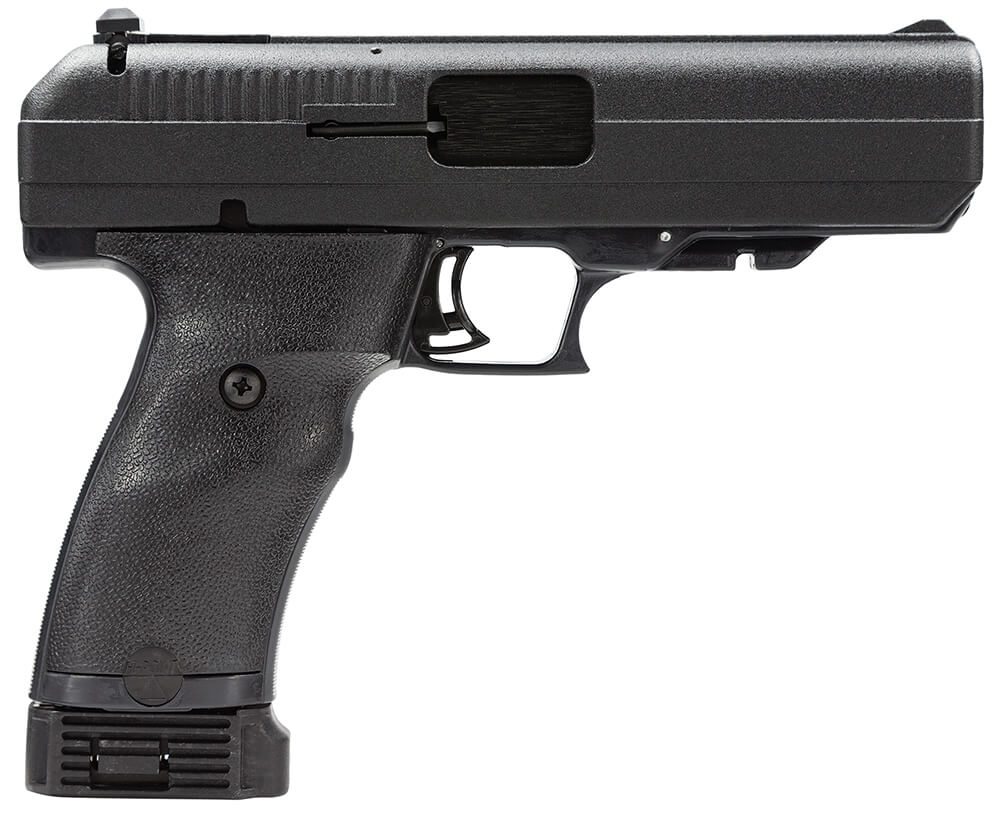
The Hi-Point pistol-caliber carbines are usually well received by shooters, but their pistols seem to not have that reputation. But, peel away the hyperbole, drama, and angst and what do you have left? A pistol that is (arguably) ugly but is built like a brick (out)house and is backed by stellar customer service. How do I know? I owned one. As a matter of fact, if you surveyed seasoned shooters and asked them what gun(s) they started with, I guess 75% of them at least would mention Hi-Point.
The gun is blowback-operated, hence, the massive slide. These guns are very simple in construction but tend to last a long time. If you are looking for a nice, basic B-flat .45 for home or truck, this gun is ideal. Available in black or camo, and in 9mm, .40 S&W, and .380.
Best .45 ACP Pistols: Sig Sauer P320 Nitron
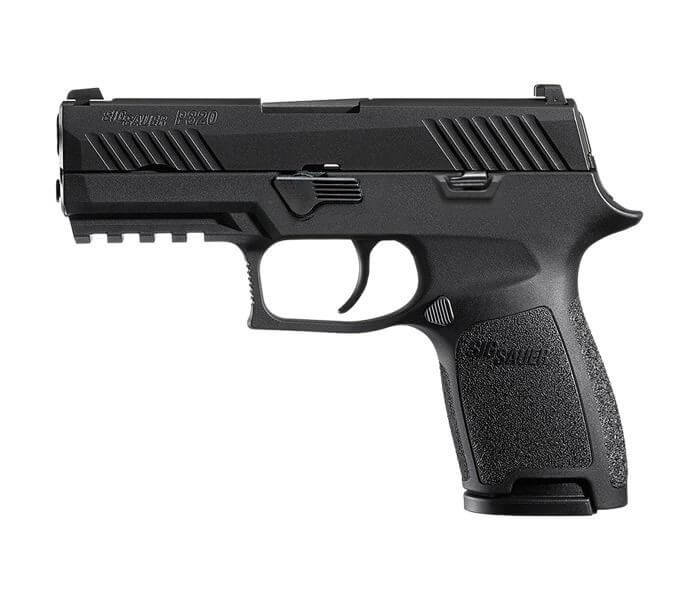
The Sig Sauer P320 Nitron .45 ACP was introduced in the U.S. in January, 2015 at the SHOT Show in both 9mm and .45 ACP. The gun is a first cousin of the 9mm P320 variation that was adopted by the U.S. Army as the M17. This is basically the P320 with upgrades and changes that the Army wanted, such as:
 Ambidextrous safety (which is different from the no-thumb-safety civilian version)
Ambidextrous safety (which is different from the no-thumb-safety civilian version) Sight frame cut-out for optical sight
Sight frame cut-out for optical sight Tactile loaded chamber indicator
Tactile loaded chamber indicator A trigger “mud flap†that prevents debris from entering the trigger opening and other changes.
A trigger “mud flap†that prevents debris from entering the trigger opening and other changes.
Sig announced on January 19, 2017 that their pistol was to be adopted by the U.S. Army in two forms, the M17 (full-size) and the M18 (compact). In May, 2017 it was announced that the first pistols received would go to the 101st Airborne Division. Subsequently, the other service branches adopted the gun. The task of replacing the Beretta M9 then in use has been completed, with a total of 421,000 M17/18 pistols deployed.
The P320 is unique in that it is a modular design. The serial-numbered part is the fire-control unit, the guts of the pistol. The grip frame is swappable. Whether you want a full-size, compact, sub-compact, there is a Sig frame you can order, not to mention different colors.
The pistol also comes in three other calibers: 9mm, .45 S&W and .357 Sig. With these three smaller calibers, you have the option of not only swapping grip frames but, by buying the parts, converting your gun to another of these three calibers. The .45 ACP is a bit more rotund, so .45-chambered P320s are not able to be converted to one of the other calibers mentioned due to the larger frame size and magazine well needed.
You can, however, buy different size grip frames and have a compact carry .45 AND a full-size range or home-defense gun that has the same controls, trigger pull, and sight picture.
Sig Reliabilty
The P320 is the striker-fired version of the P250, a solid seller for Sig. The P250 is a DAO/ hammer-fired weapon and is readily available. It’s just that, in today’s pistol market, striker-fired guns are all the rage, so Sig was happy to oblige.
The P320 is a fine example of a combination of two ideologies: the well-known reputation Sig has around the world for its brawny, reliable guns, joined with the current trend for polymer-framed striker-fired pistols. Another factor in the P320’s favor is the price. Most steel- or alloy-framed Sigs have a manufacturer’s suggested retail price well north of one thousand dollars. The P320 is made to sell for less, but not be cheaply made.
If you are looking for a .45 that you can carry inside your waistband, the P320 Carry model is for you. If you are looking for a .45 that you can carry in an inexpensive range holster with a full-size grip frame, the P320 Carry model is for you. I could go on, but you get it. This is one versatile pistol, and for a CCW carry gun is hard to beat.
Wrap Up
A pistol chambered in .45 ACP can be a thing of beauty. Although we didn’t touch on 1911s. There are several pistols that would get the job done for a host of eventualities. If all you’ve shot is 9mm, you at least need to try a .45. Some of these guns seems to shoot their larger-diameter bullet softer than some 9mm guns shoot their smaller bullets. It has to do with recoil impetus, but I’m no physics expert. I just know that, if I’m going out to my backyard range to just sling some lead, more often than not I’ll grab a .45. and have a lot of fun.

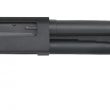


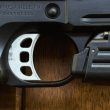
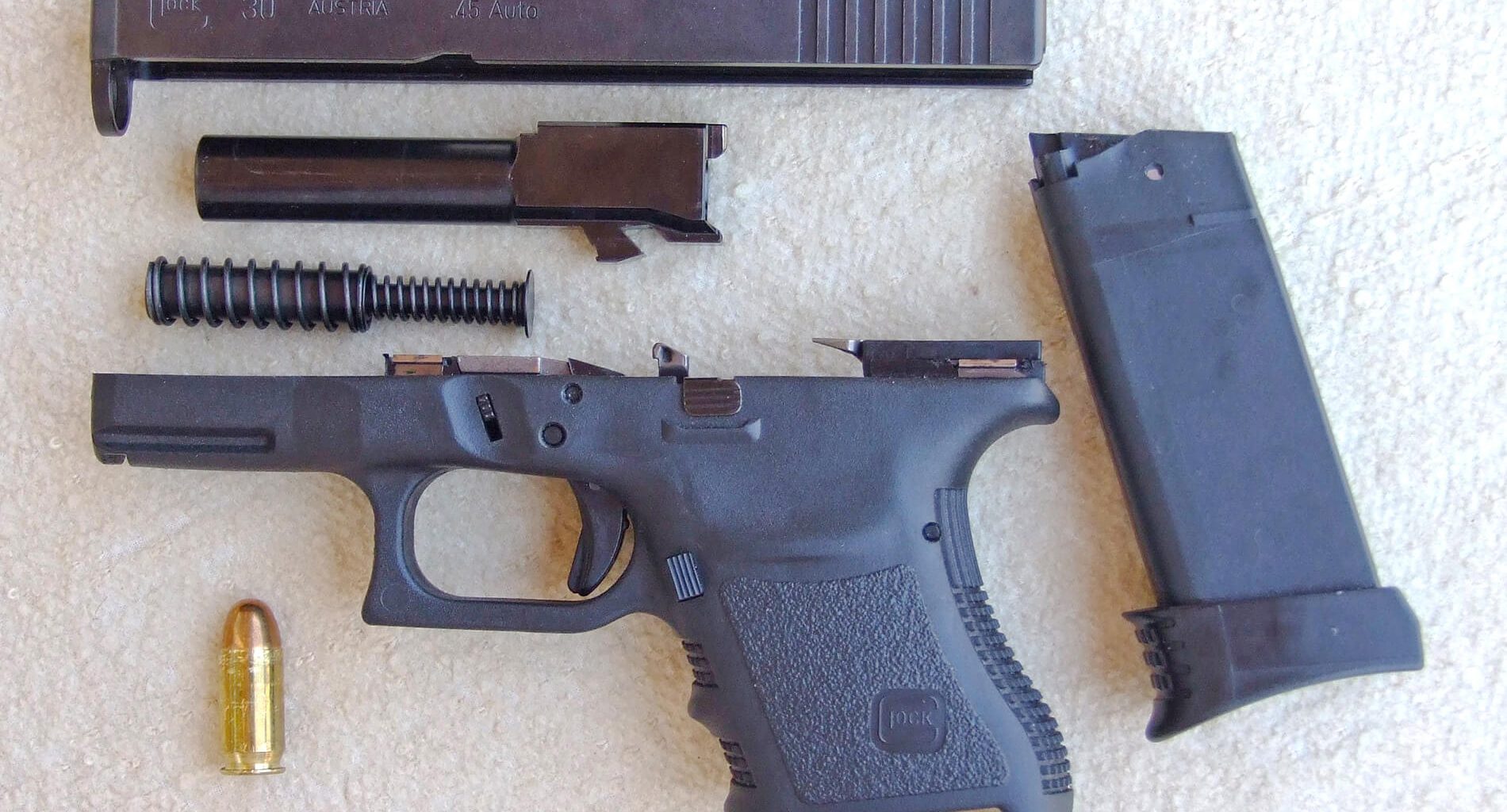
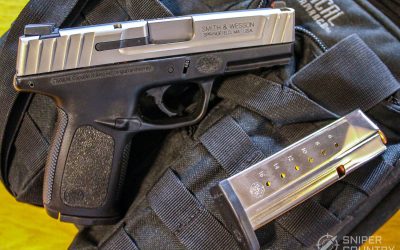

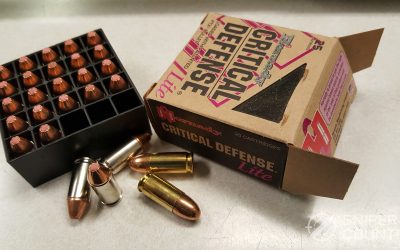

![9mm Glock Models [Ultimate Guide]](https://www.snipercountry.com/wp-content/uploads/2018/10/Glock-17-vs-Glock-19-vs-Glock-26-vs-Glock-41-vs-Glock-43-WM-400x250.jpg)
![Handgun Caliber Chart [2025 Ultimate Guide]](https://www.snipercountry.com/wp-content/uploads/2018/10/Handgun-Caliber-Comparison-400x250.jpg)
![Rifle Calibers [Ultimate Guide]](https://www.snipercountry.com/wp-content/uploads/2018/12/Header-1900-400x250.jpg)

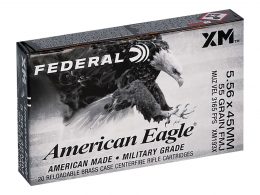
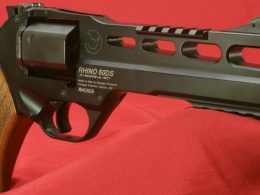
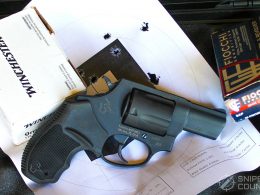

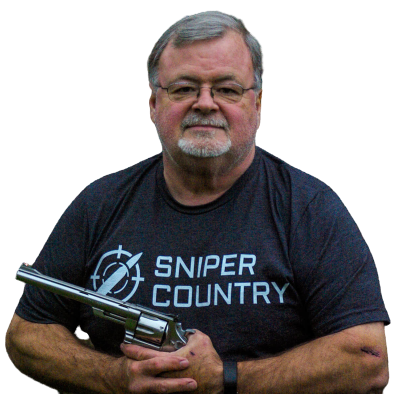
Thanks for the reviews. I bought an FNX .45 TAC for my Marine son and would have liked to hear your review of it. Instead of a brick It feels more like a 12″ concrete block, but I liked the threaded barrel and the stability it retained when shooting suppressed. And of course, the double-stack capacity. It’s like carrying a Desert Eagle: The only way one carries IT concealed is in a winter parka or in a wheel-chair.
Thanks for the reviews.
Thanks for the kind words. I know what you mean about the FNX .45 … it is a chunk! But it’s a great gun, made by a company with a good reputation in military arms. It is a big gun to carry, but there are holsters out there for it. And, I’ll bet your son appreciates it…after all, a Marine deserves the best!
What would be the best full sized semi pistol in 40s&w, 45acp, 9mm I’m going after the most commonly used military or police ammo it will be used mostly for plinking and competition among friends
David,
I really like my Springfield XDM. Personal opinion, of course…there are many good choices out there. The full size XDs in .40, .45, 9mm and 10mm offer a lot, including a grip safety. I just today stippled the grip on my XDM, but if you get an XD Mod. 2, that’s done already. The S&W M&P pistols are good, as are the Glock models. You really can’t go wrong with any of these. Hope that helps!
Enjoyed the reviews. Always something to be learned by keeping an open mind. As a reloader myself fpr over 40+ yrs,always trying something new;going by the specs,of course.
I agree with putting the Glock 30 at #1. Mine is the easiest shooting pistol I have. Less felt recoil and muzzle jump than my G17, G19, CZ-75, 1911, and HiPoint 45. At least as accurate as the rest (more accurate than most) of my guns, plus the brass all gets ejected into a pretty small area so easy to pick up. Some of my guns (esp the G19 and HiPoint) fling brass all over the county it seems like.
I own a Colt defender .45 ACP 3″. Best Semi Auto I have ever owned.
The FNX 45 acp has saved my life more than once. Very reliable, durable and love the capacity. Hard to believe it is not in your top five. It is my number one go to in all offense or defense operations. Like any other 45 acp it is not for the meek.
JCLH, yeah, the FNX is one of the great pistols. I just had to draw the line somewhere and tried to include guns in more than one price range. If I do another update, that gun will be included. I really like the FNX, just had to stop somewhere. Thanks for writing!
This is a nice list of plastic guns but the Sig P220 is by far the best. 1911 or otherwise.
Mac, the P220 is a great gun. My state police carry it. I had to include a variety of guns, and some shooters want more than 8 in the magazine. In my review of the 22o (not published yet) I say how much I like the gun. I appreciate you writing!
Again, the Sig 250 was left out, guess the newer Sig got the attention.
Bill, yeah, they’re similar except for the hammer vs. striker. I just had to draw the line somewhere. Both guns are fairly similar, and both are great buys – your choice would just depend on whether you are a DAO/hammer or striker fan. I appreciate your comment.
It would have been useful if you’d included magazine capacity for each gun in the description. It’s a major issue with .45 ACP.
George, I’m not sure what you’re looking at – capacities are listed for all six guns in the drop-down “Specs” boxes. Do you have a specific question about a certain gun? Thanks for writing!
My mistake; I was talking about the description text, where – for the Springfield XD – the capacity had been called out, and didn’t realize you had a separate, drop-down specification box. I tend to skip over things that look like ad links, etc. when I am reading, and it didn’t register. That makes the article a very comprehensive treatment of these pistols, well-researched and documented. Thanks for the response, and thanks for the hard work!
George, glad to help. I just write reviews the way I would want to read one, all the details. Hope this one helped you…glad you found the specifications drop-down box. Thanks for writing back!
Everyone has their favorite, and I own several 45 ACP pistols. My favorite is the Sig P227
Rick, great choice. Our state police carry the 220 – they agree that Sig makes a great gun. Thanks for writing!
Love that caliber for the stopping power alone. One shot does the trick no matter where it lands.
Bert, a lot of folks agree with you. I sure like the caliber. Thanks for writing again!
nice article giving some tribute to these guns and paper weights, however you didn’t mention the Rock Island Armory 45, I have the 45/22LR conversion and it’s a very nice shooter a direct copy of the 1911, never had any issues with it at all and it groups very well. Yes it’s made in the Philippines and sold through Armscor out of Pahrump, Nevada. A great gun for less money than many of the others.
Mark, I agree – they’re great guns. I did mention the RIA in my article on budget 1911s. I’ve owned two of their 1911s (plus their .38 revolver). The guns are a great buy. The .22 conversion kit – is that an RIA-branded product or a third-party one? I’m just curious. Thanks for writing!
I never really got into the .45ACP, as I entered the handgun fraternity as a revolver fan. It would be 15 years before I purchased a semi-auto, and at that time, fatherhood prevented spending a whole lot, and options to the 1911 were few. When .40 S&W hit the market, I soon jumped on board with that cartridge, and still like it for its performance, although my CCW for the last 3 years has been a 9mm. Suffice it to say, the .45 ACP “bug” never bit me LOL.
At this time in my life, adding another caliber would likely result in marriage counseling (the wife believes I own and reload for far too many as it is), unless a really sweet deal comes along or I win the Lotto, it’s doubtful I’ll add .45 to my list. 10mm I could get away with, as my .40 S&W dies will handle 10 as well.
Great read and review Mike. You’re one of the few reviewers, I look forward to reading.
Bemused, first, thanks for the kind words. As I say, I write reviews in the style I’d like to read them – more details than most reviewers include and with a touch of humor added. As for not being into the .45, that’s fine. It’s just one of many good calibers out there. I do have a soft spot in my head …er, heart… for the old punkin ball. I’ve reloaded it for 40 years and just have fun with it. Thanks for writing again – I always enjoy your posts.
Nice article, Mike. I concur that the G30 is a very good choice for CCW. However, in my experience at the range with either factory ammo or reloads (no cast projectiles), all of my 1911s are far more accurate than this Glock. Do I just have a lemon or perhaps I haven’t found the right ammo? What do you think, Mike?
Unknown, keep trying different ammo. I did shoot my cast loads through my 30 – I just cleaned it every time. They are target loads so pressure wasn’t an issue. Just keep trying loads, factory and handloads, until you hit one that works. Your 30 may not match your 1911s in accuracy, but it shouldn’t be too far behind. Keep us posted, OK? Thanks for writing!